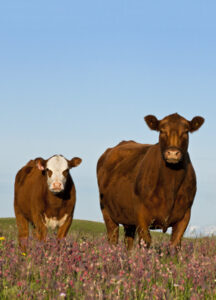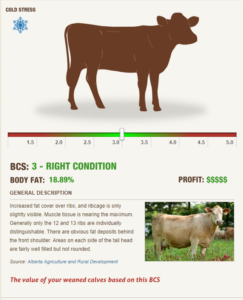The hand is better than the eye when it comes to cattle condition
Remarque : cette page web n’est actuellement disponible qu’en anglais.

Reproduction is the single most important factor in the productivity of a cow-calf operation. Body condition (amount of fat cover) is a key factor in reproductive success. New research from the Western College of Veterinary Medicine suggests that a body condition score (BCS) of 3.0 is the ideal fat cover for beef cows for several reasons, including:
- very high pregnancy rates
- very high percentage will show estrus 30 days after calving
- high calf weaning weights
- low abortion and stillbirth rates
- low risk of severe dystocia
Body condition scoring is a low cost, hands-on method to determine the condition of cattle. This easy hands-on method is much more accurate than just looking at the animals.
Thin cattle (BCS less than 2) typically will have issues with cycling and conceiving and have an extended period to return to estrus. Calves from thinner cows have also been shown to have reduced vigor at birth. Fatter cattle (BCS greater than 4) are more expensive to maintain and may fail to cycle and conceive altogether.
Fat levels on cows going into the winter will have an impact on winter feeding options and costs. Cows going into the winter with extra fat will require less energy over the winter than cows going into the winter in thin condition.
Cows with an ideal body condition score (3.0) rebreed up to 30 days sooner than thin cows, which allows more cows to calve in the first 21-day cycle. This can add up to 42 lbs in calf weaning weight. Cows in ideal body condition also have pregnancy rates double those of cows in poor condition, have improved milk production, fewer cases of abortion and stillbirth, healthier calves, and have fewer instances of calving problems. The salvage value of cull cows in good condition is also higher.
A study completed at the Elora Beef Research Station in Elora, Ontario determined that visual assessment of BCS are not similar to measurements taken using ultrasound technology. Looks are deceiving.
- Initial investment to adopt hands-on scoring is generally $0.
- Time required takes approximately 15 seconds per animal to score and may take some additional time or pens to sort and feed the animals based on their condition.
- To reduce time, you may want to do a sampling of animals rather than the entire herd.
- For greater accuracy it may be best if the same person completes the scoring to reduce the variation between scores.
- The learning time takes approximately 5 minutes.
Learn how by watching the video below and visiting www.bodyconditionscoring.ca
What they did:
Data was collected over three years at three different stages of the production cycle: dry period (January to March), nursing period (June and July) and weaning period (October). Body condition was assessed visually by a team of three experienced assessors according to a scale ranging from 1 to 5 in half unit increments, where a score of 1 = very thin, 2 = thin, 3 = good condition, 4 = moderately fat, and 5 = extremely fat. Ultrasound images were taken between the 12th and 13th rib within 3 weeks of the body condition scoring.
What they found:
There was not a strong relationship between a visual assessment of body condition and ultrasound assessment of fatness regardless of the stage of the production cycle of the cattle or the experience of the visual assessor.
Across Canada, there is a downward trend for the adoption of body condition scoring (BCS). According to previous studies, 23.4% of operations were scoring the body condition of their animals on farm. New results from the 2017 cow-calf surveys across Canada have shown regular BCS is performed and recorded on 17% of operations in Western Canada, 26% in Ontario and 17% in Atlantic Canada. This downward trend is concerning because there are several benefits for operations that measure body condition in order to maintain cattle at ideal levels.
Management of cattle in various body conditions has shown an improvement in Western Canada with up to 56% of operations feeding according to body condition as of 2017. In Atlantic Canada, 33% sort breeding females according to body condition.
To learn more about the proper techniques for BCS and the economics behind it, test drive the updated BCS calculator on the BCRC website. (click the image)
Click here to subscribe to the BCRC Blog and receive email notifications when new content is posted.
The sharing or reprinting of BCRC Blog articles is welcome and encouraged. Please provide acknowledgement to the Beef Cattle Research Council, list the website address, www.BeefResearch.ca, and let us know you chose to share the article by emailing us at info@beefresearch.ca.
We welcome your questions, comments and suggestions. Contact us directly or generate public discussion by posting your thoughts below.
